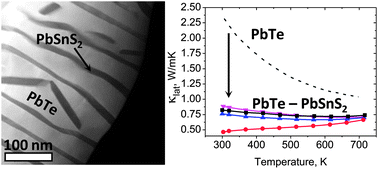Recent advances in the field of thermoelectrics have shown embedding appropriate nanostructures can significantly suppress the lattice thermal conductivity and therefore enhance ZT. Here we report a new class of thermoelectric composites of PbTe–PbSnS2. PbSnS2 is a naturally layered material (space group Pnma) comprised of Sn–Pb bilayers approximately 0.6 nm in thickness. High resolution transmission electron microscopy reveals the PbSnS2 segregates into coherent lamellar structures 50–100 nm in thickness that extend 100 nm to 15 μm in length. Despite the relatively large size of the PbSnS2 precipitates, we find that incorporation of PbSnS2 in PbTe results in significant reduction in lattice thermal conductivity to 0.4–0.65 W m−1 K−1 over the temperature range 300–700 K, a reduction of 50–70% over bulk PbTe. As a result, a maximum ZT of 1.1 is obtained for ingot samples of the PbTe–PbSnS2 6% composition. We provide extensive characterization of the physical, structural, and chemical properties of this materials system including powder X-ray diffraction, infrared reflectivity, scanning and transmission electron microscopy, and thermoelectric properties measurements. The synthesis method is simple and general, opening possibilities for similar systems to yield materials exhibiting low lattice thermal conductivity without it being necessary to embed nanoscale (5–20 nm) features.

You have access to this article
 Please wait while we load your content...
Something went wrong. Try again?
Please wait while we load your content...
Something went wrong. Try again?


 Please wait while we load your content...
Please wait while we load your content...